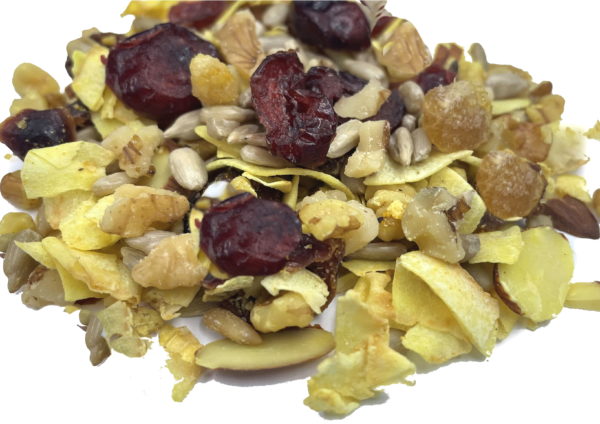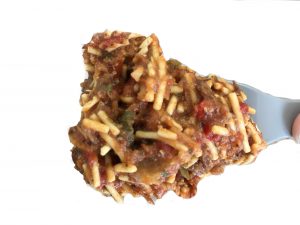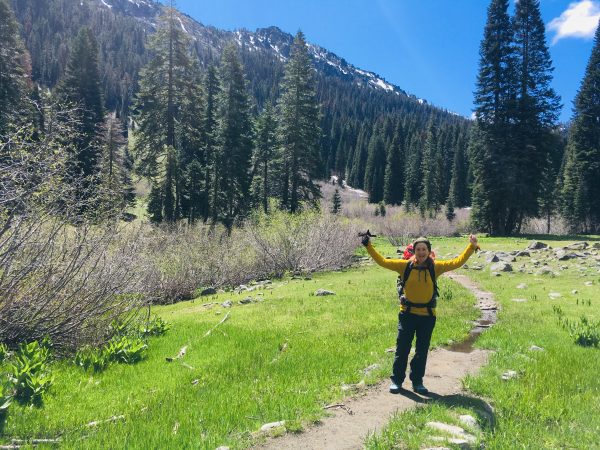After exerting all that energy to carry the weight of your food on your back, the last thing you want to do is to lose valuable calories by eating carelessly. Chewing your food thoroughly is one of the most important and overlooked things you can do to improve calorie and nutrient absorption from trail foods.

How to Maximize Calorie Absorption
Digestion starts in the mouth before it can happen in the stomach and intestines.
Chewing your food not only breaks the food down into smaller pieces so it can be swallowed, but the saliva from your mouth releases carbohydrate-digesting enzymes. The more your teeth grind away at the food, the longer the enzymes are exposed to the food, making it easier for the next stage of the digestive process.
Chew Food to Micro Bits!
Chewing is primarily an unconscious act, and most people chew food about 5 times, which is not nearly enough!
How much chewing is needed to maximize the release of all those nutrients? There’s no specific number of times you must chew — it depends on the food. Simply chew your food until it is nearly liquified inside your mouth or broken down into micro bits.
Chewing food to micro bits may require 30 to 40 chews for energy-dense solid foods, which tend to be harder to eat, such as seeds, nuts, and chewy fruit leathers. Softer freeze-dried foods, tiny bits of dried fruits, and cooked grains will require less chewing, from 7 – 10 chews.
- Nuts & Seeds can require up to 40 chews to break down the tough cell wall to release all of the calorie-rich lipids [1]

How Chewing Improves Nutrition
- Chewing is the first step of digestion. Chewing food releases saliva and digestive enzymes (amylase) to begin the process of breaking down food in the mouth so it can be swallowed and pushed to the stomach.
- The stomach continues digesting the food by mixing it with more enzymes so it can be released as energy.
- The small intestine mixes with more enzymes to break down the food further, and any food nutrients are absorbed in the small intestine.
- Waste is passed to the large intestine or colon which is later excreted.
If you do a lousy job of chewing, you’ll know it because the food will pass straight through you as wasted energy.
Have you ever spotted undigested food in your stool — such as corn, seeds, or nuts?
That means you did a lousy job of chewing.
Not only does this mean you wasted energy carrying the food, but you also penalized your body by not giving it enough nutrients. You can’t absorb the nutrients needed to replenish energy stores and build muscle when you don’t chew your food well.
Speaking of bad eating habits, here are a few others that you don’t want to adopt:
- Heaping food on your spork so that a portion of it falls off and lands in your lap, or on the ground.
- Clumsily transporting the loaded spork to the mouth, causing food to land outside the mouth, on the chin, or clothing.
- Adding more food to the mouth before swallowing what’s already been chewed in the mouth, thereby causing spillage, coughing, or choking.
- Eating too fast; in other words, not chewing enough.
The benefits of eating carefully and chewing your food thoroughly include:
- Less waste from food spills.
- Increased absorption of nutrients, including protein, fat, vitamins, and minerals. [2,3,4]
- Improved digestion by reducing the risk of bacterial overgrowth in the colon, which may lead to abdominal pain, bloating, and gas.
Prolonged chewing is an important, yet overlooked way to absorb the most nutrients from your trail food. A secondary benefit is that it conserves energy; Digestion is one of the most energy-consuming processes of the body, so maximize muscle energy by doing a better job chewing your food!
Many of us eat quickly, so we could benefit from chewing more.
Cheers to eating well and becoming a champion chewer on the trail!

Related Posts:
[1] Ellis PR, e. (2019). Role of cell walls in the bioaccessibility of lipids in almond seeds. – PubMed – NCBI. Ncbi.nlm.nih.gov. Retrieved 30 September 2019, from https://www.ncbi.nlm.nih.gov/pubmed/
[2] Cassady, B., Hollis, J., Fulford, A., Considine, R., & Mattes, R. (2009). Mastication of almonds: effects of lipid bioaccessibility, appetite, and hormone response. The American Journal Of Clinical Nutrition, 89(3), 794-800. doi:10.3945/ajcn.2008.26669
[3] Rémond D, e. (2019). Postprandial whole-body protein metabolism after a meat meal is influenced by chewing efficiency in elderly subjects. – PubMed – NCBI . Ncbi.nlm.nih.gov. Retrieved 30 September 2019, from https://www.ncbi.nlm.nih.gov/pubmed/17490964
[4] Why is chewing such an important part of digestion?.(2019). Whfoods.org. Retrieved 30 September 2019, from http://whfoods.org/genpage.php?tname=dailytip&dbid=337